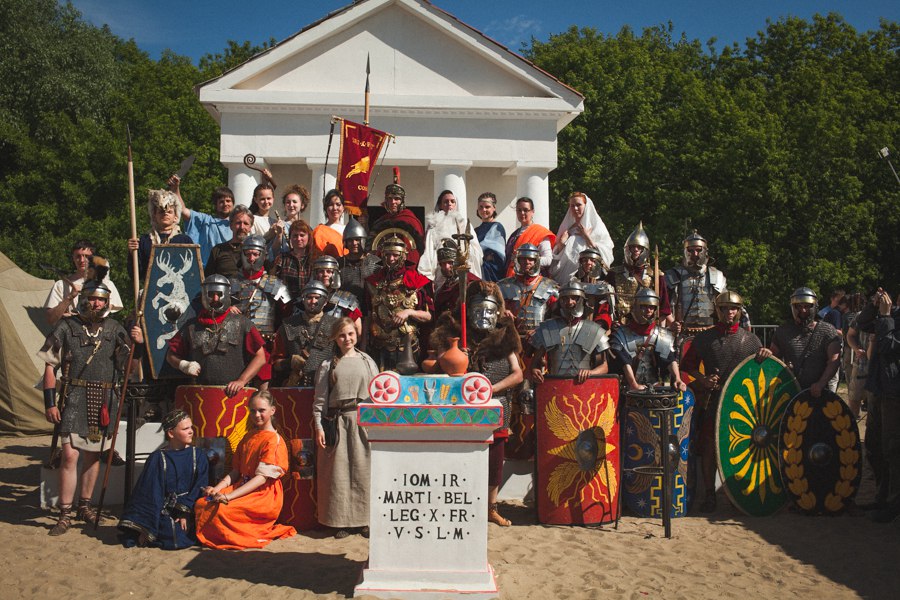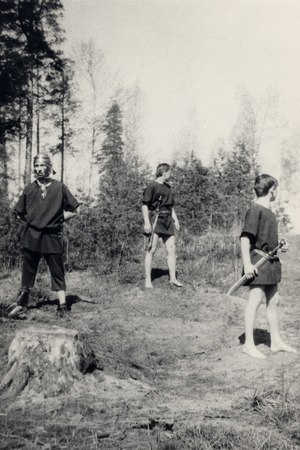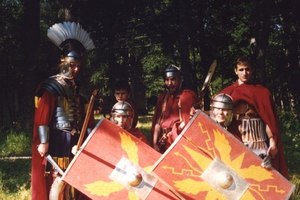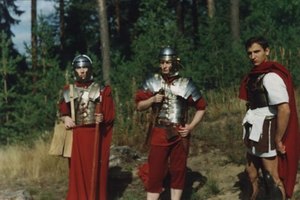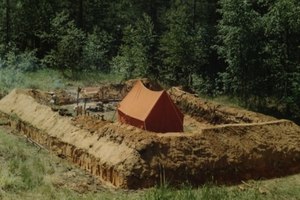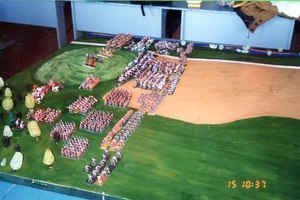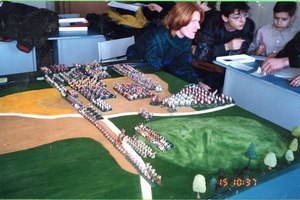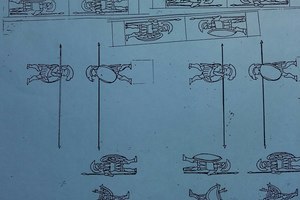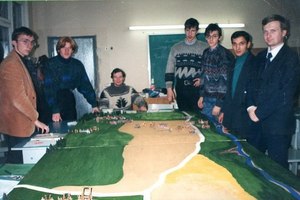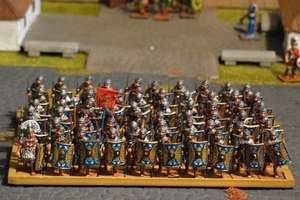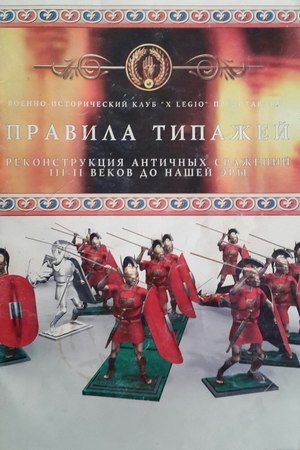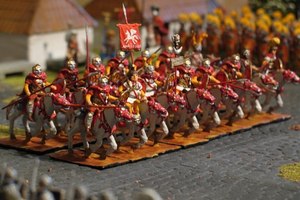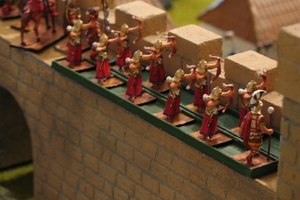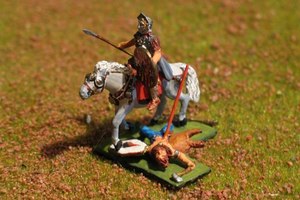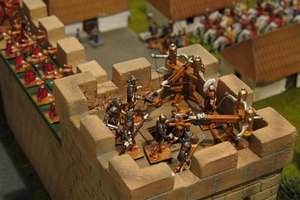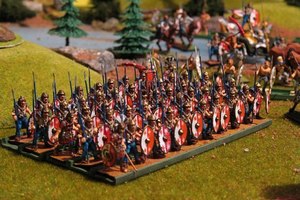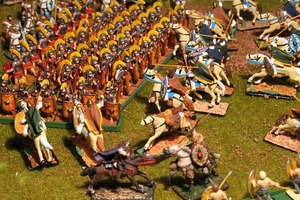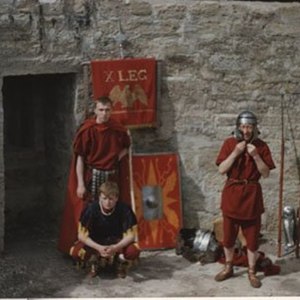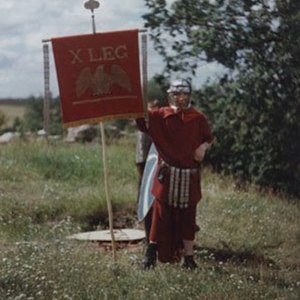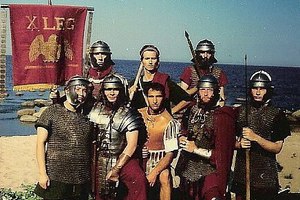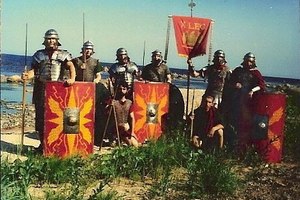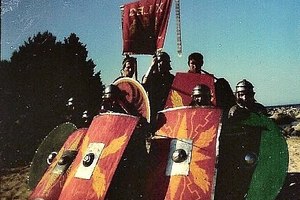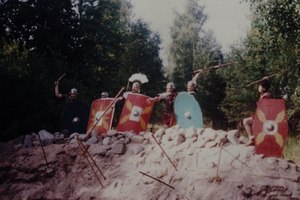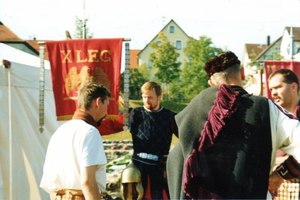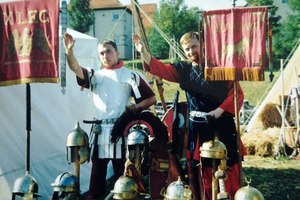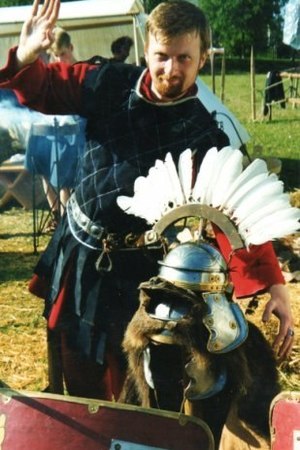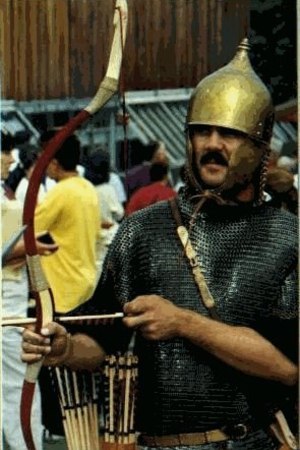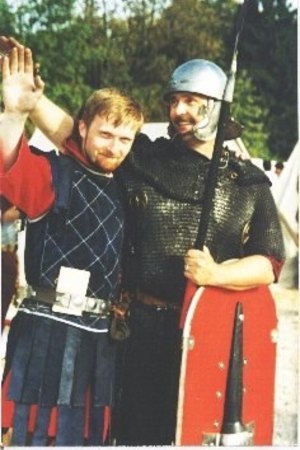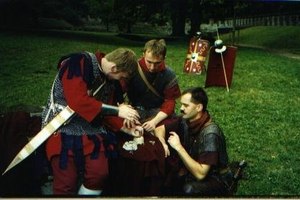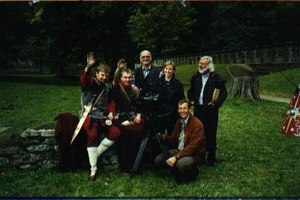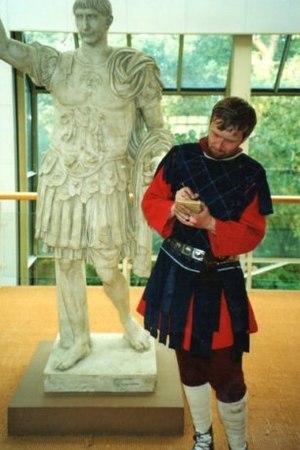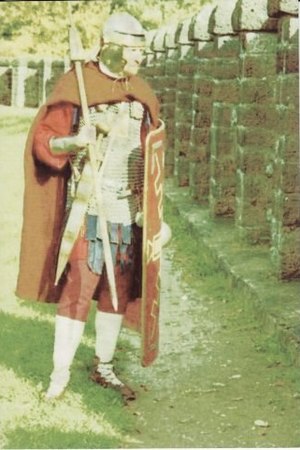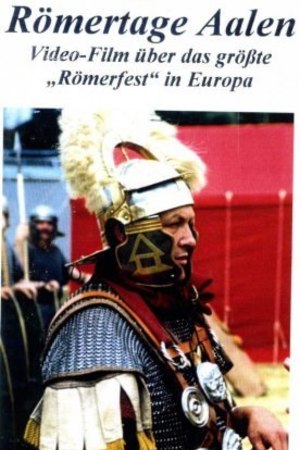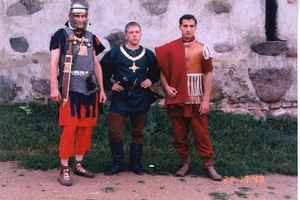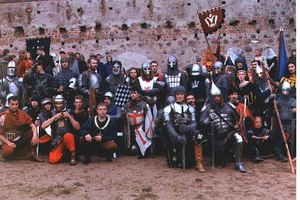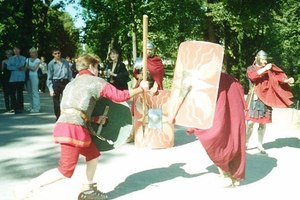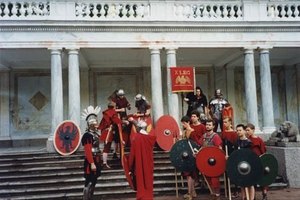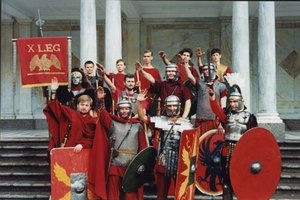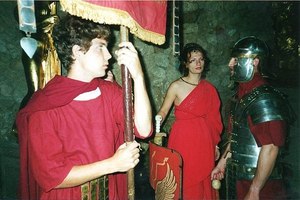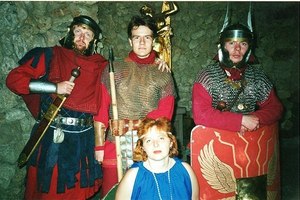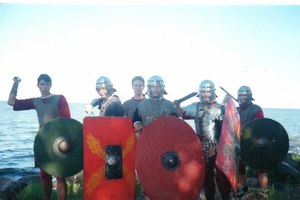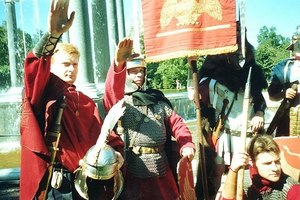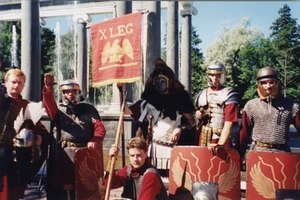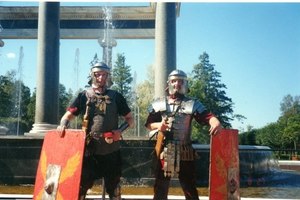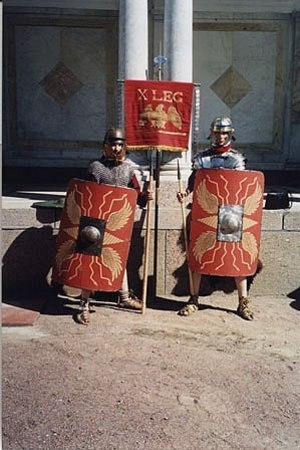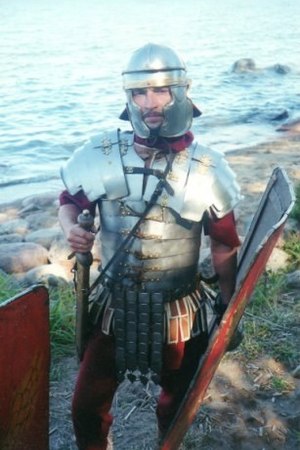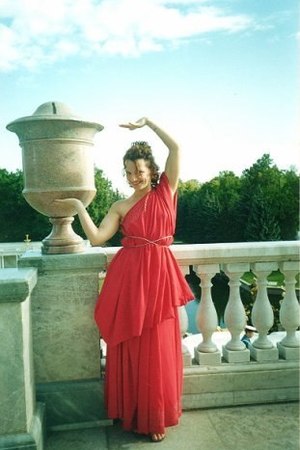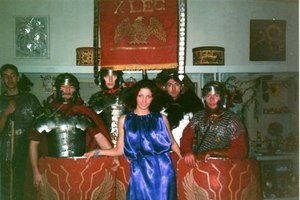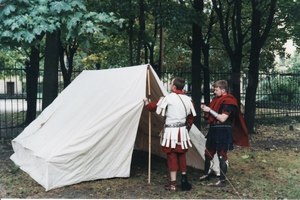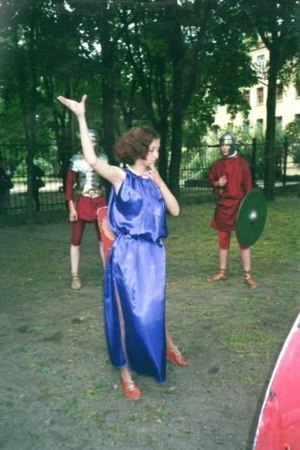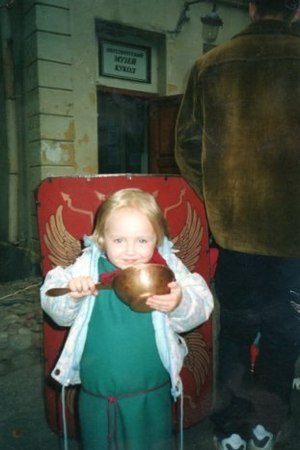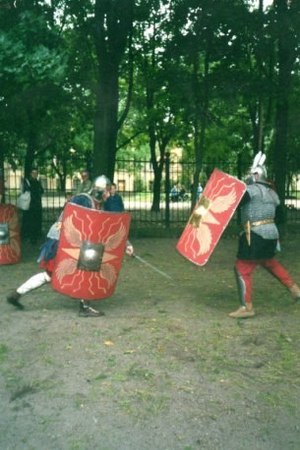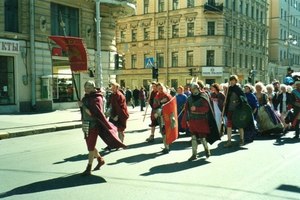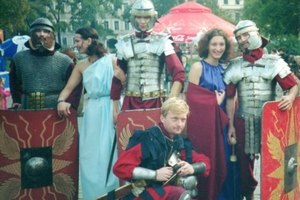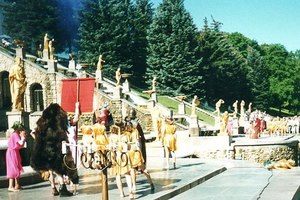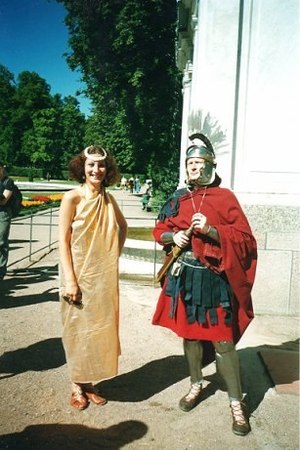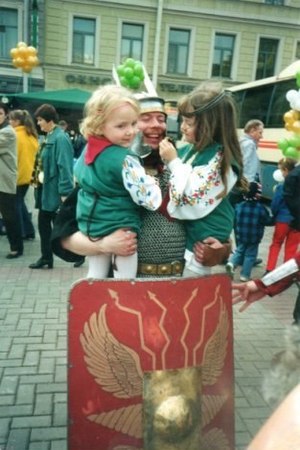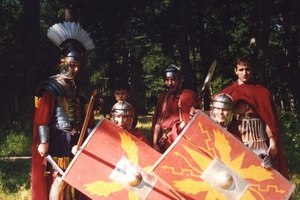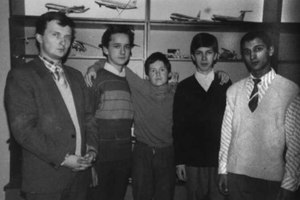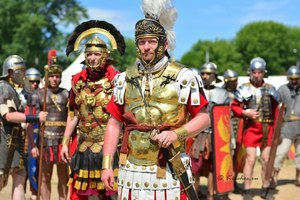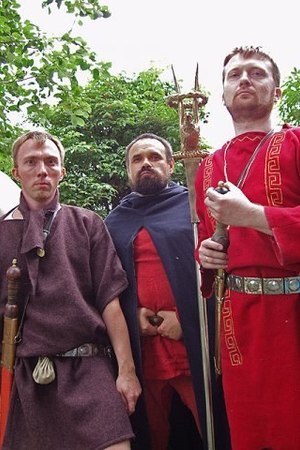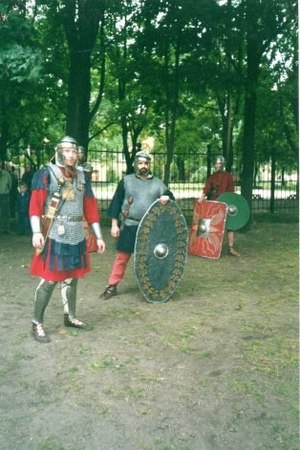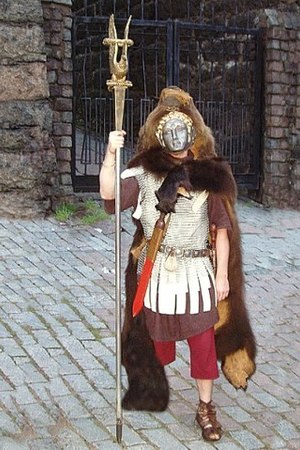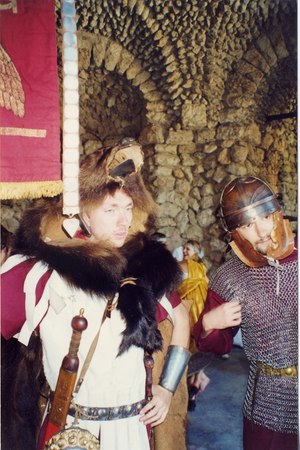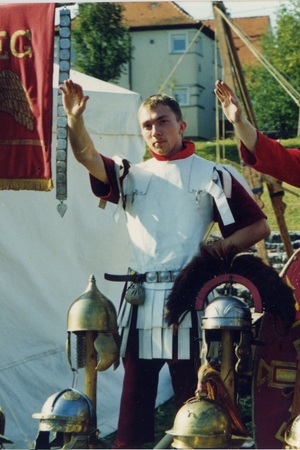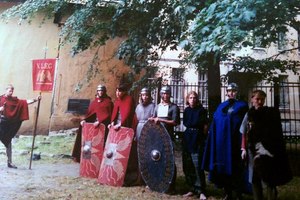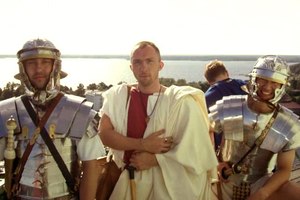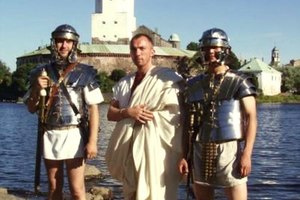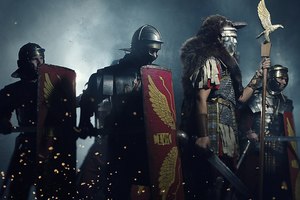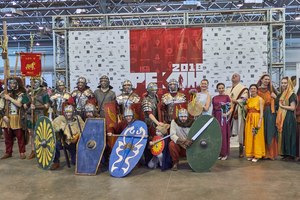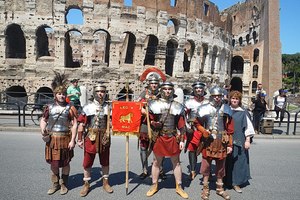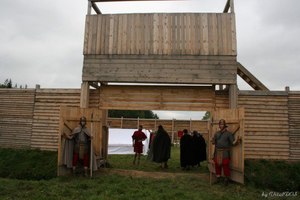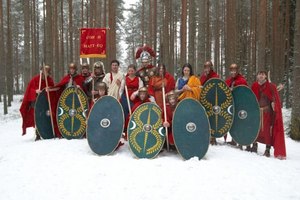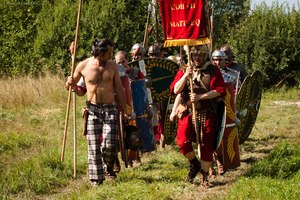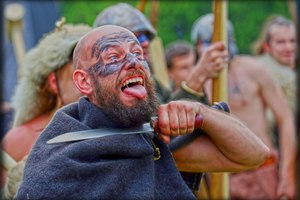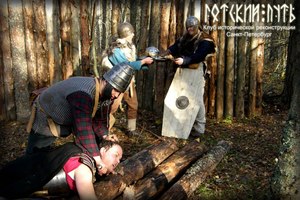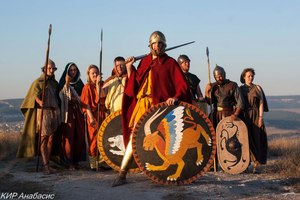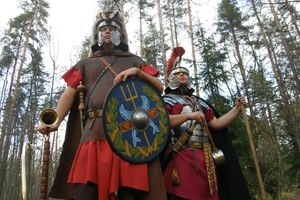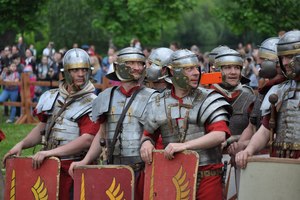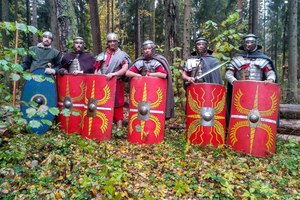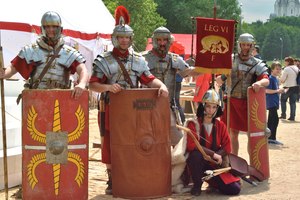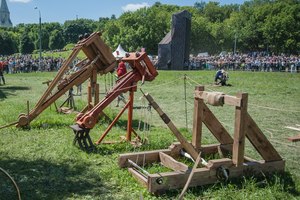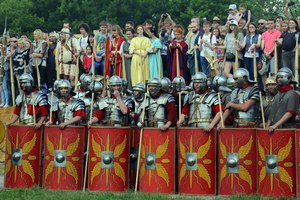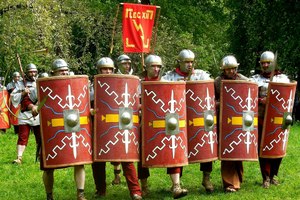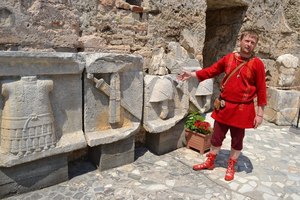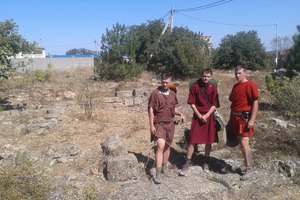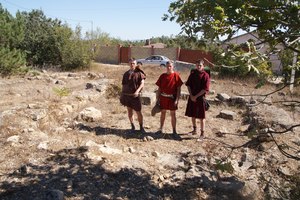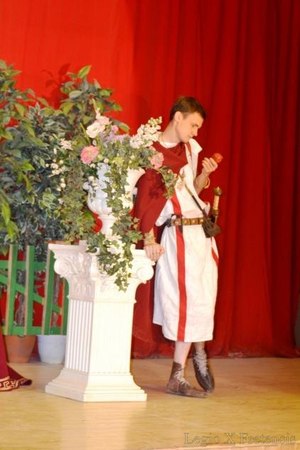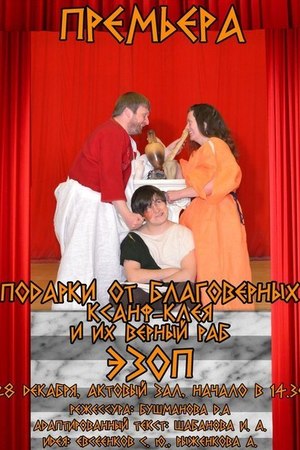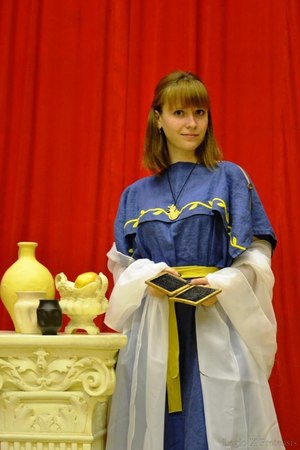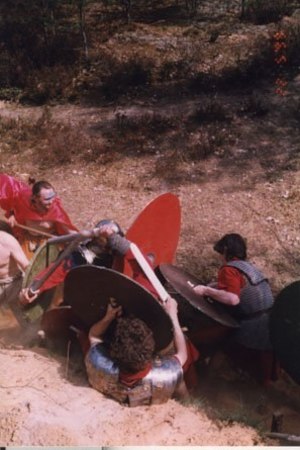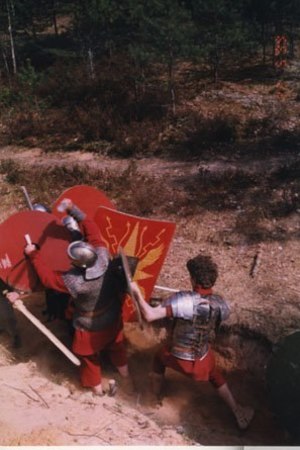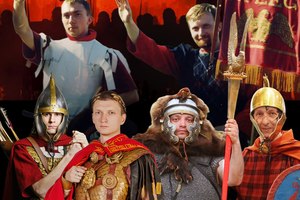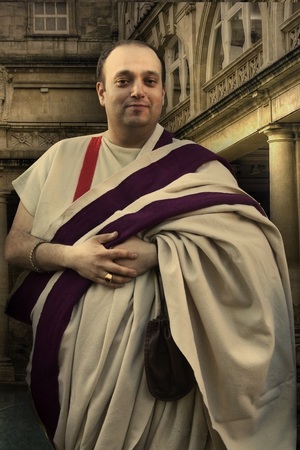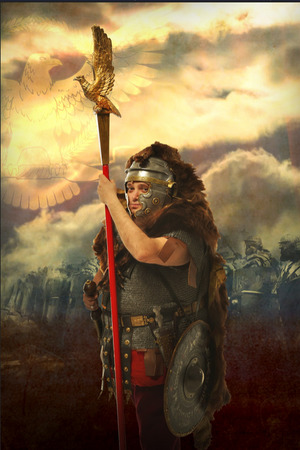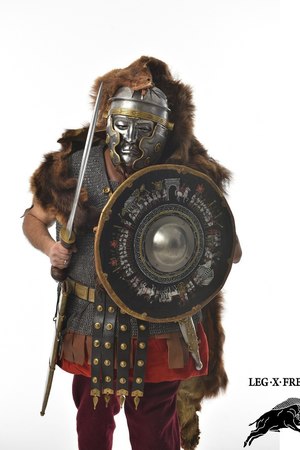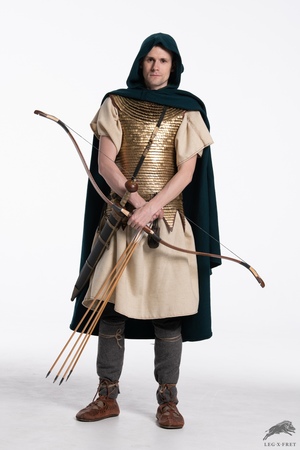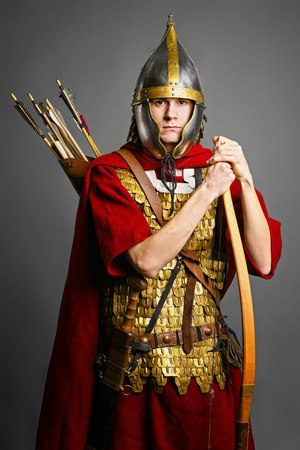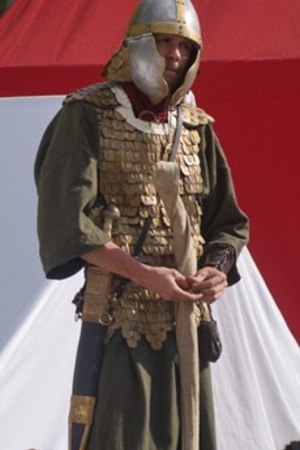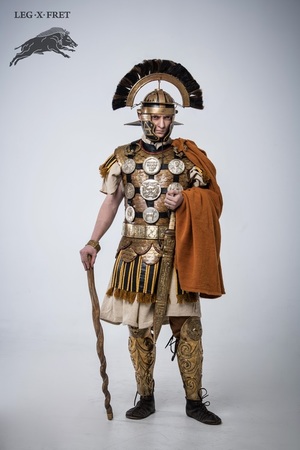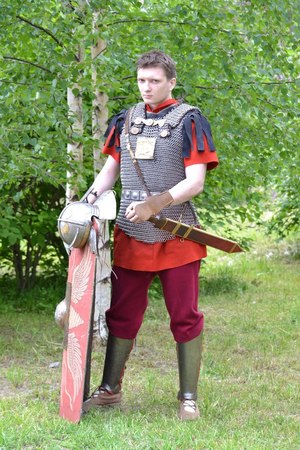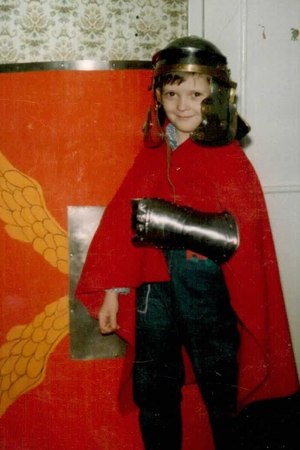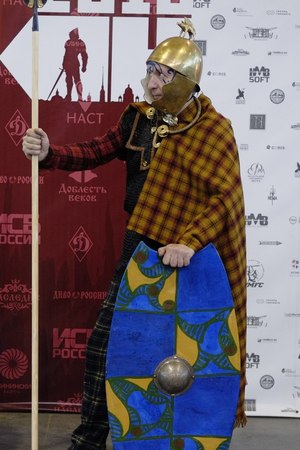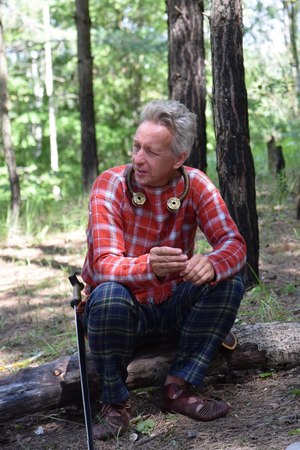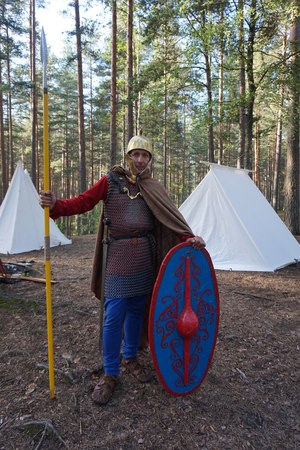History of the Ancient Russian movement
"My dear comrades - Miletes and worthy quirites, time flies relentlessly, and it is time for me, as the oldest participant in our common cause, who is still in service with the iron legions of Rutenia, to remember many things. Luckily, since February 23, 1991, a lot of water has flowed, and our club, along with the entire ancient movement in Russia, has a significant history worthy of mention!" - Sergei Italian (Yevseenkov S.Yu.), one of the founders of the ancient movement in Russia.
P.S. Rutenia is a slang name for Russia, as one of the provinces of the Roman Empire according to the "Roman historian Tacitus."
Here you will find unique information about the history of the ancient movement in Russia. Want to know how it all began? What did the first Russian reconstruction of a Roman helmet look like? How did the idea of an ancient Roman club itself emerge? Where and how were the first maneuvers conducted? Enjoy!
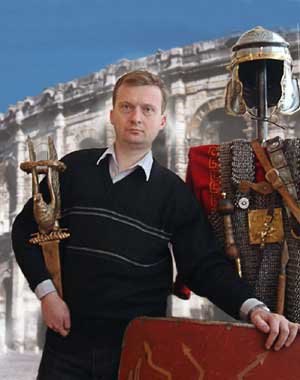 Evseenkov S. Yu. - one of the founders of the ancient movement of Russia
Evseenkov S. Yu. - one of the founders of the ancient movement of Russia
First Assembly of "Legio X Fretensis"
What can motivate people to engage in reenactment? Today, as a rule, many people join the movement through acquaintances or by learning about it from mass media sources. But what can motivate people when there are no such sources, like the familiar internet, or even clubs dedicated to your favorite era?
The answer, as expected, is on the surface - love for the era, passionate hearts, and a sea of enthusiasm to do something. For some, the prerequisites for seriously engaging with Rome were their childhood interests, while for others, it was movies and books. It all started with small things - with popular miniature models in 1:72 scale, long before 1991. But soon, everyone wanted to fully experience the grandeur of Rome, and several enthusiasts began their challenging path as reenactors. February 23, 1991, marked the birth of the club and the entire Roman ancient movement in Russia.
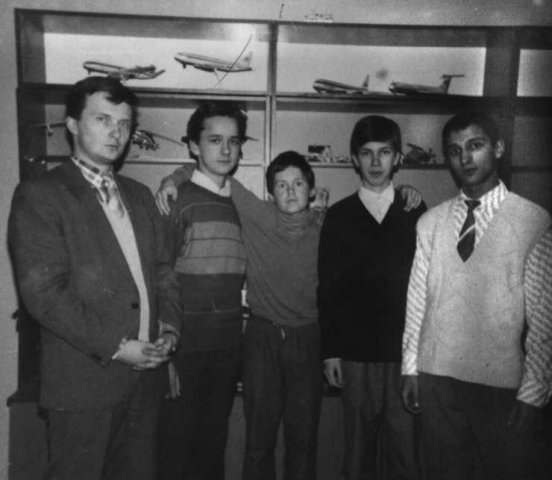 First Legio X Fretensis meeting, mid-February 1991. The photo shows-From Left to right: Evseenkov Sergey Yuryevich, Surin Nikolay, Chipux Kirill, Ivanov Fedor and Gorets Alexander Valeryevich
First Legio X Fretensis meeting, mid-February 1991. The photo shows-From Left to right: Evseenkov Sergey Yuryevich, Surin Nikolay, Chipux Kirill, Ivanov Fedor and Gorets Alexander Valeryevich
Sources and the First Parade
In the early 1990s, access to archaeological data was much more challenging than it is today. In the information age of the internet, where you can conduct superficial searches on any question within 5 minutes. The main source of information was books with publications on archaeological excavations. There was no established knowledge base for ancient reconstructions. The lack of information sometimes led to inaccuracies in reproductions. But this did not stop the enthusiasts, who constantly worked on their mistakes and promoted the ancient movement in Russia.
April 1993, School 323 in the Nevsky District of St. Petersburg, inner courtyard. The first parade of "Legio X Fretensis." The photos show the first reconstructions in Russia of tunics, Imperial Gallic helmets, Pompeii-type gladii, caligae (footwear), and marching bags.
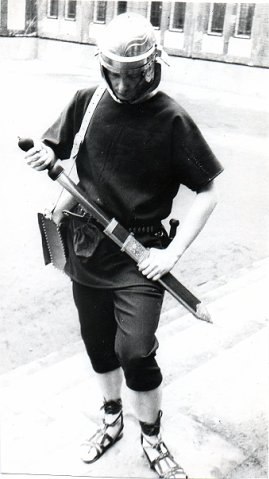 The first reenactor in Russia to collect the minimum set of legionnaires
The first reenactor in Russia to collect the minimum set of legionnaires
First Field Expedition
May 1994. The first field expedition of the Tenth Legion and, at the same time, the first Roman maneuvers of the Ancient Movement of Russia. Dean of the Guard Yaroslav Fyodorov leads a patrol of two velites from Viktor Efremov's detachment.
The Tenth Legion was rapidly developing. Even then, they began to think about more interesting representations of the Roman army than just legionaries. The ideas included centurions and legates. People gathered their kits at different speeds, as they do now, depending on enthusiasm and opportunities. There was enough material, and soon the first "Feathered" Roman representation, the centurion, was recreated. Based on the stereotypes of that time (and even now), the main distinction of a centurion from an ordinary legionary was the presence of a "crest." In our time, with a sufficient knowledge base, mistakes in the representation are immediately noticeable - combinations of lorica segmentata with a subarmalis and a fringed apron together, long sleeves of the tunic, and armguards are extremely rare in reliefs. However, the image of the first domestic centurion is unmistakable at first glance.
First Roman Military Camp
This time, let's remember the first attempts in Russia to create a Roman military camp. And it happened in the summer of 1994. Finally, on color photographs, the military camp "Alexandria Lembovskaya" of Legio X Fretensis is depicted.
Nowadays, the question of digging trenches has arisen again during major modern events such as maneuvers in Khotkovo and the Crimean Military-Historical Festival. As they say, everything new is something well-forgotten old. Enthusiasts dug a trench around the perimeter in the forest and built a rampart around the camp. Of course, the content of the camp at that time was not the most "accurate," but the work done can only be admired! Even to this day, very few people are willing to manually reproduce such defensive structures during maneuvers!
Following the construction of the camp, the issue of its security arose. After all, it was a Roman army! Thus, the question of guards and code words immediately arose. The glorious tradition of sentinels and patrols during events with a military camp is still preserved in our club!
Miniatures
As mentioned earlier, 1991 was just the beginning of the path for reenactors in the usual sense of the word for us. Before that, the club existed as a group of people passionate about history, trying to immerse themselves in the grandeur of Rome in any way possible. The first attempt in this endeavor was playing with toy soldiers, and initially, they were "cardboard armies" in the literal sense of the words. Much later, in the early 1990s, alongside the development of reconstructions, miniatures also actively began to develop as one of the club's directions, naturally focusing on Ancient Rome. The games quickly gained popularity and soon became one of the favorite pastimes of the "Legio X Fretensis" club.
The photos are from 1995-1996.
The "Golden Age" of the Tenth Legion's miniatures can rightly be considered the beginning of the 2000s. In 2002, the "Archetype Rules" were released, creating an original domestic fully balanced gaming system. Numerous tournaments and campaigns were held. A vast range of models of soldiers in ancient themes was created. It seemed that the well-known "Warhammer" series of tabletop games was within reach, but such grand plans were not destined to come true...
After the rapid growth of the miniature modeling direction in the club, the general interest sharply declined by the end of the first decade of the 2000s. This system consumed too much energy from the enthusiasts. This coincided with a decline in interest in historical domestic wargaming across the country and among other eras, giving way to other foreign systems outside historical settings in narrow circles. Over time, the Tenth Legion delved deeply into reconstruction, and the massive armies (literally) retired, occasionally demonstrating themselves in battle to this day.
The second half of the 1990s
Everyone strives for diversity and authenticity, and the Tenth Legion was no exception. Everything was new at that time: armor, helmets, training, battles. But we wanted not only to conduct forest maneuvers for ourselves but also to immerse ourselves more in the era using other locations. We began to take an interest in semi-abandoned fortresses. The first such fortress was Koporye, where Roman maneuvers were first conducted amidst tactical fortifications.
May 1995. In the first photo: Yaroslav Fedorovich, Sergey Evseenkov (Sergius Italius), Yuri Evseenkov - the honorable vexillarius of the "Legio X Fretensis" (putting on a helmet before battle).
The First Ancient Roman Festival
At first, the club held closed events "for themselves" (I believe this format is familiar to many readers), but over time, there was a desire to "bring antiquity to the masses." And for this purpose, a similar closed format was not suitable. Thus, the idea arose to organize the first festival, which was named "Meetings on Ladoga." It was the first large-scale event coordinated with various administrations, which was already a significant achievement in itself.
The Tenth Legion organized demonstration battles, storming of fortifications, and other performances that became part of the festival program of ancient clubs and are popular to this day.
1996, mid-July. Ancient festival "Meetings on Ladoga" (1-2). Legio X Fretensis.
Unfortunately, the festival did not go as smoothly as desired. The substantial success of the event, by the standards of that time, was overshadowed by the first serious injury.
Just like today, battles with real "muruses" and other defensive formations were popular among Roman reenactors at that time. They fought not only against regular targets but also with real combat structures. Alexander Viktorovich Kostyrya (known in the Roman world as Fabius) received a penetrating wound to his hand during a combat encounter at the maneuvers.
Here is an interview with an eyewitness, Sergey Yu. Evseenkov (Sergius Italius):
"It happened on the shore of Lake Ladoga during the filming of a staged segment for a local television station. I warned Gorts that the sand was dangerous, unlike soil. He said it would be fine, just softer to fall on. And then, during the final general battle, Auxiliary Maxim Zykov, swinging a saw, slipped on the sand and struck Alexander Kostyrya (Fabius) with the blunt 16mm blade, piercing his wrist! Fabius pulled the saw out of his hand and continued fighting (!), after which I ran to the camp in full armor, called for medics, and drank some water... The result was a loss of health... He should have walked a few laps around the stadium, but he thought he would be fine. Kostyrya developed a blood infection. After this incident, due to family circumstances, it became much more challenging for him to engage in Rome. That's how the first combat injury in the history of the ancient movement in Russia happened."
Since then, the health of club members has always been the top priority for the "Tenth Legion," and special attention is given to the issue of humanization.
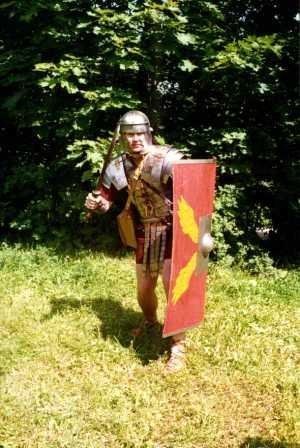 Alexander Kostyrya (Fabiy) at the festival "Meetings on Ladoga"
Alexander Kostyrya (Fabiy) at the festival "Meetings on Ladoga"
The "Roman Day of Aalen" Festival
The year 1998 was quite challenging for club members: a crisis began in Russia, and there was a severe lack of money. However, this did not prevent them from undertaking one of the most daring acts at that time - a trip to Germany for the Aalen Ancient Festival. The inspiration for this trip came from a regular videotape (in the pre-internet era, they were a valuable source of information) about Roman reenactment in the city of Aalen, as shown in the last photo. In September 1998, the first club trip abroad to Germany was successfully organized.
This trip was not only important for participating in the Aalen Festival itself. It became a significant opportunity for the first exchange of experience with foreign reenactors, such as A. Zimmermann. In the West, the phenomenon of ancient reenactment is much more widespread than in Russia. This is partly due to the fact that the reenactment movement itself has existed there for much longer, but the main influence comes from cultural and historical connections, which are naturally stronger there. So, this somewhat daring trip had a significant impact on the development of the ancient movement in Russia. And it conveyed an important message: no matter how difficult the situation is, dreams can be realized. The key is to have the desire and start taking action.
In the first three photos: Zalsburg Castle. Filming by the "CDF" channel for the documentary-drama film "The Roman Limes District."
Antiquity in Belarus
Antiquity took its first steps on Belarusian land in July 1998. The medieval festival at Mir Castle was chosen as a platform for its dissemination. Rome appeared as a "rare bird" in this event, but nevertheless, it was one of the first close contacts between antiquity and other epochs, which largely defined the style of conducting multi-era events.
In the photo in the lower left corner: Alexander Gorts and Vladimir Sipinsky (Valentius in the Roman world) among the participants of the Medieval Festival.
"Samson-Hercules-Heracles"
The year 1999 was marked by the growth of popularization of the ancient movement. The club began to gain recognition, although not to the extent desired. A new stage of development was the collaboration with Peterhof, within which the "Samson-Hercules-Heracles" festival took place in August 1999.
The partnership with Peterhof proved to be fruitful. One of the main achievements was the organization of not just a single event but an annual series. As is well known, the key to the success of any event's development is its repeatability year after year, in the same location. This allows for the improvement of event organization and makes the project more attractive to tourists. The series of "Samson-Hercules-Heracles" festivals, which began in 1999, successfully continued for several years.
"The tin soldier is serious!"
Another event in which the Tenth Legion actively participated and which took place over several years was "The Tin Soldier is Serious Business!" At that time (2001-2002), battles with tin soldier types were still extremely popular in the club, so participating in such an event was very interesting. This interactive exhibition showcased Roman army equipment, elements of civilian life, and demonstration battles - in short, everything we love! It is particularly noteworthy that the first authentic Roman tent in Russia was showcased at this event (last photo).
In the first photo, the following individuals are depicted: Ozhiganov O., Kostrov E., Fedorov Y., Gryaznov D., Kseniya.
Public Events in the Early 2000s
n the early 2000s, the Legion actively participated in public events of various kinds. In 2000-2002, they took part in events such as the "Tokay Wine Festival," "Bread Festival," "Levretki-II," and the "City Day Procession in 2001."
The Aquila of the Tenth Legion
And now we come to the appearance of the main symbol of any legion. This war sacred relic soars proudly above the armies, inspiring heroic deeds. The loss of this priceless treasure marked the disbandment of the legion. Of course, we are talking about the Aquila - the Golden Eagle. On September 15, 2004, our club acquired this foundational symbol of war and the grandeur of Rome. Yaroslav Fedorov became its first bearer (aquilifer).
Here is the story by Sergey Yu. Evseenkov (Sergius Italius): "The history of our valiant Aquila was sacred in its own way. Our unique artifact was born (designed based on Peter Connolly's book 'Greece and Rome at War'). The proud eagle was sculpted from domestically produced modeling clay, which made its subsequent shaping by Valery Ogarkov quite challenging. He was a great master in his craft and created a semi-finished master model. It was sculpted by a famous sculptor from the iconic studio of military-historical miniatures, 'Russian Knight.' The Aquila was completed in 1999 and lay in 'special storage' for years
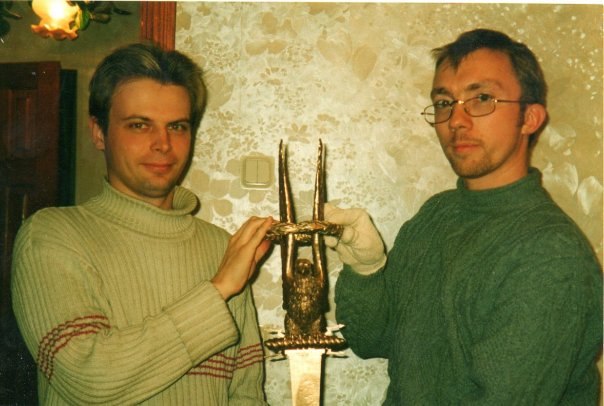
The First "Ancient Blacksmith"
In addition to organizing the personnel and events themselves, the history of reenactment clubs is not without the role played by masters who are willing to explore and try something new together with club members. The first such blacksmith for the ancient movement was Alexander Timofeev. His first works dated back to 1992. During his active career, he created numerous artifacts, including the first Thorax (anatomical armor) in Russia. The photo is from June 2002, during the presentation of the "Sledopyt" magazine at the book fair in the Ice Palace.
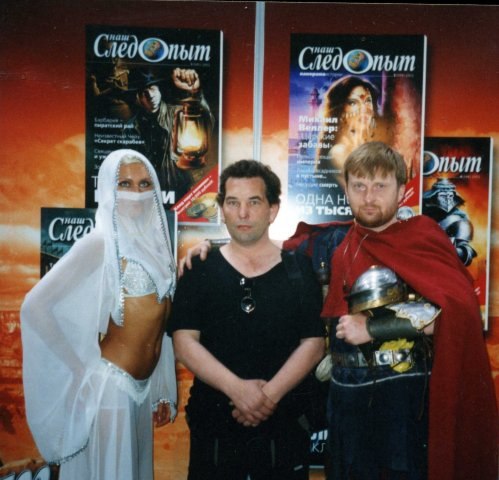
Founders of Russian Ancient Reenactment
In addition to the legion itself, which has enough years to write a whole history, there are individuals whose stories are directly connected to the club and are equally lengthy and interesting. Today, we will talk about one of them, whose name has long been associated not only with the Tenth Legion but also with antiquity itself. We're referring to one of the founders of the Russian Ancient Movement - Sergius Italius (Sergey Yurievich Evseenkov). Being part of the club since its inception, he was a leader of the Tenth Legion for a long time. He started as an ordinary legionnaire but didn't confine himself to reproducing historical images in one place. According to the "military hierarchy" of the legion, Sergius Italius went a long way, serving as an optio, a centurion, and currently holding the highest rank possible - Legatus. However, he always emphasizes that his favorite object of reconstruction has always been and will be the centurion.
The contribution of Sergey Y. Evseenkov to the ancient movement is hard to overestimate. He has long been the main enthusiast, inspiring many to engage in reconstruction and overcome difficulties. However, his contribution cannot be solely characterized by the reconstruction of the Roman army. At various times, he organized civilian movements, ancient theater, and even conducted ancient rituals as a priest. This legendary person is still active to this day, although not as actively as before. He is the only one who started the movement and represented it during the Times and Epochs event held on June 9-11. Antiquity, barra!
Unfortunately, in the history that unfolds and develops over a long period, there are sometimes irreversible and sad events. Today, we will talk about one extremely important person in the club's history who, unfortunately, is no longer with us - Dmitry Gilgov.
Interview with Sergey Y. Evseenkov:
"Dmitry was the leader of the VOLNAYA VATAGA club, and I was introduced to him by one of the graduates of my school. He was interested in early Russia, Varangians, and Novgorod Ushkuyniks.
Essentially, he had dual membership. Being the leader of VOLNAYA VATAGA, he was also a member of our club. He paid dues and even held leadership positions in our club.
His main contribution was organizing maneuvers... VOLNAYA VATAGA built a structure above our camp (called 'Alexandria Lembolovskaya'), like a tower-watch. It became the main training ground for battles with the Vataga! Some dates related to his active activities in the Tenth Legion: He created the auxiliary unit around 2001.
Due to health problems, he later withdrew from active reenactment activities and started working in theater, traveling to different venues under the name 'Mr. Peugeot's Theater.'
In the first photo: Yaroslav Fedorov, Dmitry Gilgov, Sergey Evseenkov.
One of the most important members of the club who played a key role in the early days of reenactment is Yaroslav Fedorov - the first Aquilifer of Russia, the one who set a new standard in civilian Roman reenactment.
Yaroslav's introduction to the club began in November 1993. "I came in response to an announcement that was hanging in the DVK (House of Military Culture). It was November 1993. There were Sergey Evseenkov, Alexander Goretz, and another blacksmith, Alexander Timofeev. There was a helmet of Cassius and some medieval helmet on the table," recalls Yaroslav's first memory of the club.
It was there that one of the most significant encounters for both the club and the entire movement took place. From that moment, Yaroslav's journey as a reenactor began. Starting as a legionary, he participated in numerous campaigns and battles. Over the years, he excelled as a reenactor, organizer, and simply a reliable person. Climbing the military hierarchy of the club, he first became a standard-bearer and then, as one of those who created the Legion's sacred symbol, the eagle, he became an Aquilifer. Like no one else at that time, Yaroslav dedicated himself to one of the main reenactment pursuits - studying sources, which was quite challenging due to the lack of the internet. He initiated the most grandiose trip of the club in the 90s: to the historical festival in Aalen, Germany, where he was able to learn and implement many things in terms of the "reenactment of ancient school" in Russia, thus contributing to the creation of the Legion's library and the transfer of knowledge. After Aalen, he actively contributed to the development of the domestic and civilian aspects of the ancient reenactment movement in Russia. He also delved into an important part of ancient culture - religion, becoming the first Pontifex (priest). Building upon the knowledge acquired in Germany, he embarked on the creation of Roman military equipment, but the project did not materialize and was carried out only more than 10 years later by the club's current active members.
Legates, representatives of the highest officer ranks in the Roman army, are currently a very popular portrayal within the Russian Ancient Movement. However, like everything else, there is always a beginning, a moment when this portrayal was first reproduced. The first Legate of Russia was Alexander Gorets, one of the founders of the Tenth Legion.
Being one of the first enthusiasts of antiquity in Russia, Alexander began active work not only in recruiting new club members and developing their kits but also in building knowledge bases and physical training. Starting from 1992, club meetings between events began to take on a familiar appearance seen in modern military-historical clubs, with active lectures and intense physical workouts. All of this contributed to the development of club members, both externally and internally, as it is widely known that this forms the foundation for advancing club activities.
"Alexander was an excellent and charismatic leader who knew how to take initiative and take responsibility for failures and mistakes" (Sergius Italius).
Over time, Alexander's interests shifted towards journalism and archaeology, distancing himself from club affairs while focusing on the magazine "Parabellum," which initially started as a club project.
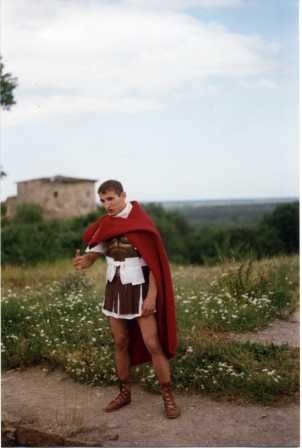
The Crisis of the Ancient Movement in 2002
After the remarkable 1990s, during which the Tenth Legion essentially had a monopoly on antiquity, challenging times came. After successful attempts at commercial activities and registering the club as a legal entity, numerous new problems arose, which club members hadn't even anticipated. Miniature production and cooperation with Peterhof and other administrative resources were going quite well. Hence, an important question arose, which sooner or later arises for any successful club: What to do next and how to strike a balance between reconstruction and commerce? Each person found their own answers to these and other questions, which eventually led to the formation of two factions and later a split within the club. The peak of this division occurred in September 2002 during the "Olovniany Soldatik - eto ser'ezno" event.
Over time, part of the active members left the Tenth Legion and founded one of the most well-known ancient clubs even to this day - the Fifth Macedonian Legion. As for the Tenth Legion, an era of stagnation and decline began, lasting nearly 10 years. Fortunately, the ancient movement suffered less than the Tenth Legion itself, as new clubs began to emerge, partially picking up the "torch of antiquity."
The following years became increasingly difficult for the Tenth Legion. There was a high turnover rate, and the activities of those on whom everything depended shifted more towards publishing historical magazines and military miniatures. One of the major classical events during that time was the 2005 "Vyborg Castle" festival. However, there were no significant updates in personnel, and many people who had been involved in reconstruction for years were affected by the "wedding fever." I believe many are familiar with cases like "got married - dropped out of the hobby" in any reenactment epoch. Eventually, due to extremely low activity, the Tenth Legion earned the nickname "Phantom Legion" for a long time.
New reenactment clubs in the 2000s
Fifth Macedonian Legion
Moving further along the history of the ancient movement, it is impossible not to mention other ancient clubs. Some, brightly appearing and leaving their mark, disappeared, while others continue their activities to this day. One such club is the Fifth Macedonian Legion, founded by former members of the Tenth Legion, the "Crusher in the Strait," in September 2002. Maria Gryaznova became the first leader of the club, and after her, Oleg Ozhiganov took over the leadership position, which he still holds today. Thanks to their previous experience and a fresh perspective on the state of ancient reconstruction, the Fifth Legion managed to make a significant breakthrough as a club and effectively carry out their activities in St. Petersburg. Over the course of their existence, they have brought many new elements to the movement, ranging from projectile war machines and local events to international trips. The Fifth Legion participated in festivals in Italy and Poland. They also don't forget about the peaceful aspects, achieving success in ancient dances and the recreation of Fayum Portraits.
"VVK Second Mattiac Cohort - Equitata"
One of the largest clubs in the late 2000s is rightfully considered the Second Mattiac Cohort - Equitata (Moscow). They began their activities at the end of 2006, quickly gaining popularity and strength. The total number of club members exceeded 20 at the peak of the club, and their most significant contribution to the Russian Ancient Movement was the Roman Fort, which became a favorite venue for maneuvers. The Mattiacs carried out their activities not only in Moscow but also beyond its borders.
Ajja Navarsky, the leader of the Mattiac Cohort, reminisces: "The main impetus for getting involved in antiquity was the well-known TV series 'Rome,' which had recently been released at that time. At the same time, some comrades sent a couple of photos from St. Petersburg by the Fifth Legion. In part, thanks to this, a group of reenactors and role-players gathered and fairly quickly decided to form a club and join the ancient movement. We didn't waste time and, within six months, created full equipment for about seven people, found craftsmen, provided them with technical specifications based on books, and off we went. We organized three of our own festivals, which were significant for that time, and the most successful one was the second one—a real fortress with interesting war scenarios."
The Mattiacs made a significant contribution to the development of the ancient movement in Moscow, setting new standards for the quality of events.
"VVK Gothic Path"
The period from 2002 to 2010 can rightfully be called the second wind of the ancient movement when various ancient clubs began to emerge, not only focusing on the Roman theme. One of the first such clubs, for which antiquity primarily meant the fierce Germanic tribes rather than the Empire of the Eternal City, was the VVK Gothic Path. The club's birthday is considered to be May 12, 2006, when two members of the club participated in a presentation to students of Lyceum No. 395 in Krasnoselsky District, St. Petersburg, as part of an open History lesson at the invitation of the teaching staff. The club's name, "Gothic Path," comes from the eponymous work of Doctor of Historical Sciences, Professor, Corresponding Member of the German Archaeological Institute, Mark Borisovich Shchukin - the St. Petersburg legend of archaeology and the kind spiritual mentor of the Gothic Path.
Yevgeny Tkachenko, a member of the Gothic Path club, recalls the beginnings of his club: "As far as I remember, the founders of the club were Mikhail Borodulin and Danila Gryaznov. Personally, I became interested in antiquity through my school curriculum, starting with Rome. By the way, I wrote a letter to some defunct website of the Tenth Legion, wanting to join. Then at some event, I approached the 'Macedonians.' By that time, I already had a Germanic spatha, and I was already interested in the barbarian tribes. So, I joined Danila Gryaznov to portray barbarians with the Fifth Macedonian Legion. Later, we grew into a separate club. Initially, I focused on the reconstruction of the Dacians. But then I decided to go with the flow and dressed up as a Germanic warrior from the 1st-2nd century CE. One of the most memorable events in the club's history was the Times and Epochs festival in 2015."
Throughout 2007, the members of the club participated in events as part of the historical reenactment club "Legio V Macedonica," which made a significant contribution to the establishment of the Gothic Path club. By the end of 2007, the Gothic Path club had fully formed as an independent group. Over time, the club experienced a decrease in numbers but grew in quality as those who were not deeply interested in antiquity as an era were naturally filtered out.
Ancient history is not only famous for Rome. Over time, the movement began to expand not only in depth but also in breadth. In 2009, the first Greek reconstruction club appeared in Russia - Anabasis. The main founders were the current leader of the club, Andrey Lovchikov, and his comrade Anatoly Burkov. The starting point for their long journey into ancient history was the "Mars Games" organized by the Fifth Legion. The main focus of their reconstruction became the Ancient Greek Bosporan Kingdom of the 4th century BCE. This made the ancient movement in Russia more comprehensive since, at that time, the dominant segment of the era was (and still is) Ancient Rome, with smaller groups of Celts and Germans in second place. However, Greek city-states, not represented in Russia until then, had been influential in shaping the culture and military affairs of the ancient world for many centuries.
Filling this gap, Anabasis also ventured into other directions, one of the brightest being Celtic tribes, which left a significant mark in history. For many years, the club actively operated in the European part of Russia (St. Petersburg, Moscow), participating in renowned events such as "Times and Epochs." They not only participated but also organized their own events. One of their favorite recurring events, featuring continuous combat maneuvers, is the "Iron River" (formerly known as "Lembolopolis").
"Fidelis Loyal Eleventh Claudian Legion"
The Eleventh Legion is now primarily known as a young Moscow-based club in the reenactment circles. Few remember that the club with this name was founded in St. Petersburg in 2008. Under the leadership of Alexander Osipov, they focused on the reconstruction of the IV cohort of Legio XI Claudia Pia Fidelis. The choice of the Eleventh Legion was due to Osipov's service location in sunny Crimea. The main source of inspiration was the finds from the Roman camp at Vindonissa. The period of reconstruction was the late 1st century CE.
The club aimed to recreate the appearance of legionnaires and auxiliaries, their equipment, clothing, and weapons. They also sought to attract people interested in civilian reconstruction and simulate peaceful life, campaigns, and military actions, participating in living-history festivals. It was planned to adhere strictly to the selected geography of the finds. The club took part in significant events such as the "Seven Epochs" multifestival, Pushkin City Day, and the Night of Museums at the Artillery Museum in St. Petersburg. Unfortunately, the club had a relatively short existence, and more than five years after its activities ceased, its remnants merged with the Tenth Legion.
More information about the club's past activities can be found on their website: http://legioxi-cl-p-f.3dn.ru/
Sixth Iron Legion
The first decade of the third millennium was rich in ancient clubs in Moscow as well. On December 6, 2009, "Legio VI Ferrata" was formed. Interestingly, its founders were a group of reenactors from one of Russia's oldest military-historical clubs, the "Moscow Dragoon Regiment." The period they reconstructed for the "Legio VI Ferrata" club was the mid-1st to early 2nd century CE.
Recruitment of "novices" began in 2010-2011, including both experienced reenactors from other periods and newcomers to military reconstruction. They were united by their interest in the glorious past of the ancient Roman army.
On June 6, 2011, the legionnaires of the Sixth Legion took to the field for the first time as part of the Guardians of Limes 2 festival organized by the Cohors II Mattiacorum (equitata) club. From this moment until today, the Legio VI Ferrata club takes an active part in a wide variety of military and historical events related to the reconstruction of the army of ancient Rome.
All this time, the knowledge base is being updated, research is being conducted on a number of historical issues, work is underway to correct, improve and increase the club's material base, and training is being conducted – a legionnaire simply has to learn combat drill.
Soon, the influence of antiquity began to penetrate deep into Russian territories, reaching Nizhny Novgorod. One of the main enthusiasts of the club, Maxim Sakulin, became inspired by the Roman world after attending events organized by the Second Mattiac Cohort and the Fifth Macedonian Legion in 2009. Just a year later, he founded a club based on the role-playing community "Iron Lightning," which consisted of Roman stylizers. The word "lightning" passed on to the new organization, which took the name "Twelfth Lightning Legion." Initially, the club consisted of only three people: Maxim Sakulin himself, Konstantin Savkin, and the captain of the community, Andrey Pan'shin, who was immediately proclaimed a legate. Since they did not plan to expand significantly in terms of the number of people, their main focus of reconstruction became the artillery with its supporting personnel. In the same year, the first ballista was created. Since then, more than a dozen functional projectile machines have been built, with Vitruvius being their diligent student.
Between the club's establishment and the start of its active activities, more than five years passed. During this time, they expanded their material base and worked with sources. The Twelfth Lightning Legion made a significant impression in 2015 at the "Times and Epochs. Antiquity" festival, where they actively participated in both the peaceful and civilian programs, showcasing their accumulated experience and strength. Over 20 people, including legionnaires and auxiliaries, participated on the Roman side, including the command group.
Despite being geographically distant from the main events associated with antiquity in the European region of Russia, the Twelfth Legion actively participates in the life of the movement. The club regularly takes part in events in St. Petersburg and Moscow. However, the fighters also remember their homeland, and the most significant event for them was the launch of the Pax Romana living history park project. The best reconstruction clubs in Russia supported its opening.
Recon-Tourism
Recon-tourism (visiting historical sites in authentic period outfits) has become increasingly popular. It allows combining a traditional vacation with immersing oneself in a specific era, which is an essential part of reconstruction. For antiquity, which began in Greece in 2010, there has always been a growing interest in visiting historical sites. Currently, recon-tourism has become more organized and widespread. What is especially pleasing is that this type of tourism has become possible in domestic territories. Khersones enjoys particular popularity among members of the ancient movement.
Antique Theater
Another actively developing area of activity in the ancient movement is theater. The Tenth Legion's first staging experience was Plautus' "Boastful Soldier." It was a relatively large-scale production, lasting 40 minutes and involving about 20 actors.
After analyzing the difficulties encountered in their first experience, the next production selected was Aesop's fables. Their main advantage was that they consisted of small instructive stories interconnected by only a few main characters.
The First Ancient Competitive Disciplines
The first steps towards creating competitive disciplines were taken in 1999 during maneuvers in Lembolovo. Even then, there was an idea of battles in a closed, limited space. However, the concept used was not a "bridge" or a "corral," but a "trench." This type of competition later ceased its development. More recently, similar battles in a confined space have been revived in the form of 9-on-9 skirmishes, also developed by the Tenth Legion.
Below are the first combat rules created by Alexander Valeryevich Gorets.
GENERAL PROVISIONS Training combat (TC) takes place in a trench with a depth of 1.5 meters and a width of 1.5-2 meters, allowing for formations of two ranks. TC simulates ancient hand-to-hand combat in a dense, including deep, formation. The trench is necessary to maintain formation when there are a small number of participants on each side.
RULES The battle begins and ends with the command of the legate. In case of noticeable injury to one of the participants, the battle is immediately stopped, even without a command. TC is conducted using real armor and wooden weapons (approximately equal in weight to combat weapons). The following actions are allowed in combat:
- Striking with a sword
- Thrusting with a sword and spear with a protector, except for strikes to the head and neck
- Pushing and striking with a shield, excluding chopping movements with the rim of the shield
- Shooting and throwing are prohibited in trench combat, not only due to the increased danger of such actions in close combat but also because they are useless in reconstructing close combat in a confined formation and to prevent dispersal of individuals into the roles of archers, dart throwers, etc.
- If the opponent's team is pushed beyond the trench, it is a clear victory for the entire unit.
- An individual warrior is considered "dead" if they receive 10 points of hits: 3 points for an arm, 5 points for a leg, and 7 points for the torso or head. A "dead" warrior can only defend themselves or exit the battle by retreating to the rear row while shouting "killed!"
A New Stage of Development
History does not stand still. It inexorably moves forward, regardless of people's desires. So today, we will begin to tell the story of those people without whom the current face of the Tenth Legion would be impossible to imagine. They all joined the club during challenging times. After the disastrous period between 2002 and 2010, the Tenth Legion earned the nickname "Legion Ghost" due to the small number of active members engaged in reconstruction activities, low activity, and outdated equipment. Only Sergius Italicus continued to believe in the club's return to a leading position in ancient reconstruction, inspired by the legion's main eternal symbol - the Aquila. As long as the Eagle soars above the legion, not all is lost. In the future, we will tell the story of those who gave the Tenth Legion a "second wind."
Alexander Bagherman. Josephus Alexander Flavius
The revival of the Tenth Legion began with Alexander Bagherman. His introduction to ancient reconstruction started in 2011, surprisingly not with the Tenth Legion itself, but with their followers, the Fifth Macedonian Legion. As a school teacher, Alexander conducted open interactive school lessons. Over time, he ventured into teaching about antiquity, wanting to invite reenactors once again. Initially, after reaching out to the Macedonian Legion and failing to arrange lessons, Alexander continued his search. Fate then led him to the Tenth Legion in the form of Sergius Italicus. In the best literary traditions, the response to his request for assistance with lessons was: "We will help you for free and selflessly, at the highest level. But on one condition - you join the Tenth Legion..."
Alexander recalls his encounter with the club and his first event:
"Sergius, who was working at School 634 in the Primorsky District, spoke to me on the phone and invited me to his school. He showed me the weapons and armor of the legionnaires, which are now stored in his museum. I saw everything, became enthusiastic, and asked what I needed to do to show these things during my history lesson on Rome at school. He said I needed to become a member of the Tenth Devastating Legion. So I joined the club. At first, I was just observing and thought it would be temporary, for the sake of work. But gradually, Ancient Rome reconstruction became my hobby and a second life outside of work.
During my time in the club, our club has transformed from being small and isolated from others to growing and gaining strength, ready to compromise and cooperate with other clubs. Due to my main job, I don't often attend festivals, but the ones I have visited have left a lasting impression. I will never forget my first festival as a reenactor, "The Guardians of Limes." It was organized by the now-defunct "Second Mattiacian Cohort."
Despite the seemingly unserious nature of this proposition, it didn't deter Alexander, and he actively engaged in club activities. In the early days, he bought all the equipment he could find and created his first reenactor persona as a legionnaire. But the legion needed a standard that unites people, a symbol that would rise above the brotherhood's shoulders. Thus, he was first promoted to Vexillarius, and later to the highest level of the standard-bearer group - Aquilifer, the keeper of the Eagle. It is not difficult to guess that not everyone is worthy of such an honor, as in the reenactment circles, any non-ordinary rank must be earned. So what led to this trust?
During his time in the club, Alexander has become one of its pillars. Although he may sometimes be scatterbrained, he can always be relied upon for support in challenging organizational matters and difficult times. He is skilled at negotiating, which has allowed for new contacts with partners of the Tenth Legion, craftsmen, recruiting (many underestimate that the willingness of people to follow someone largely determines the club's success), and leading the children's group, "Living History." Alexander served as the consul of the club from 2012 to 2014 and is currently a member of the Tenth Legion's leadership as a senator.
One could talk endlessly about Josephus Alexander Flavius, but the most important thing to say is that the Eagle of the Tenth Legion is in reliable hands!
Stanislav Linkov. Magnus Ahzek Rufus. The Story of a Sagittarius.
The second person to join the new "core" of the Tenth Legion was Stanislav Linkov, who began his journey as a reenactor in 2011. The starting point of this journey was the ancient maneuvers of "The Guardians of Limes." Magnus Rufus recounts his first encounter with the Tenth Legion:
"One of the club's founders, Sergey Evseenkov, introduced me to reenactment. I met him long before these events, back in 2006 when I was still in school. One of my main hobbies at the time was tabletop miniature games like Warhammer, The Lord of the Rings, and many other popular 'wargames' of that time. Since the gaming area was right in the school, I often interacted with Sergey, who was also a regular participant in this hobby. Later, they opened a museum of toy soldiers, where my works were showcased, along with Roman army figures that caught my attention. Much later, closer to 2011, I saw a video dedicated to the upcoming 20th anniversary of the ancient reenactment movement in Russia, and I became extremely interested. The turning point to engage in reconstruction was the celebration of February 23rd - the actual 20th anniversary of the movement, for which I made a video of the celebration and battles on the school grounds. After that, the decision to focus on antiquity was made, but a new question emerged: who did I want to become? Sergey showed me his photos taken during his trips to Germany for the world festival. There was a photo of Alexander Zimmerman (Sergey's friend from Germany) dressed as an archer. And that's when I realized who I wanted to become. In the same year, I went on my first ancient maneuvers."
Making an unconventional choice for antiquity - instead of the typical stereotypical legionnaire that the era is most famous for - Stas decided to go the path of auxiliary infantry - auxilia, specifically creating a Syrian Archer. This presented some difficulties. At that time, the legionnaire persona had been extensively studied, and a decent knowledge base had been developed regarding the equipment and techniques. However, in the case of a Syrian sagittarius, things were more challenging since this persona had not yet been fully reconstructed. The main problem was not only to assemble an archer but also to learn how to shoot a bow, which is not as easy as it may seem at first glance. Young Magnus received his initial guidance from Alexander Yasonovich, and after mastering the basics, he started developing his technique on his own.
By 2013, Magnus completed the creation of his persona, and his kit acquired distinctive features for a Syrian archer: scale armor and an elongated dome-shaped helmet. In the same year, he became the leader of the Tenth Legion and in the 2014 season, the second consul (deputy leader). Working alongside Alexander Bagherman and later Anton Evseenkov, he significantly strengthened the real activity of the club in the field of reconstruction, thereby definitively dispelling the nickname "Legion-Phantom." In 2014, thanks to qualities such as a sober perspective on what was happening, reliability, and the ability to work as part of a team, he took on the role of a senator (one of the club's leading positions), where he continues to contribute to the club's well-being to this day!
"I want to express my gratitude to all the club members who have been part of my life. There is no limit to perfection; let's keep moving forward!" - Magnus Rufus
And so the story brings us to the current leader of the Tenth Legion - Marcus Antonius Italianus. There is no person who connects the "old" and "new" history of the club more firmly. The connection to the legion is evident, and such phenomena are often referred to as the "son of the regiment." Antonius grew up in a family of reenactors and was acquainted with the club almost from birth. The first festival where he appeared as a young boy in a stylized kit was the "Meetings on Ladoga" in 1998. Due to challenging life circumstances, he was practically removed from the club's activities for more than 10 years. Nevertheless, Antonius remained with the Tenth Legion, but as an observer, witnessing both the highs and the dramatic lows of the club.
The new beginning came in 2012. Participation in the "Dushonovo Maneuvers" can be considered a "return" to reenactment. After that, Antonius became involved in almost all club events and assisted in organizational activities. Over the next few years, he earned the rank of primipilus (first centurion of the legion) and, in addition to the Roman military direction, mastered other personas, occasionally performing as a gladiator, barbarian, or even pontiff.
Antonius on the reasons for his return to the movement:
"I had been observing what was happening with the club for a long time. However, the transition from observation to direct participation in the life of the Tenth Legion happened not because of an initial connection to it. On the contrary, what was happening with the club and some of its members strongly discouraged any further involvement. The situation began to change after visiting one of the sites associated with the legion's history - the Masada fortress in Judea. To say that it was an impressive sight is an understatement. The massive rampart, the breathtakingly preserved landscapes (traces of the Tenth Legion's camp were visible) - all of it firmly settled in my memory. But, nevertheless, the decisive factor was not this moment. At that time, my friend Stanislav Linkov was just starting his involvement in reenactment. These two factors tipped the scale towards attending the nearest event - the Dushonovo Maneuvers of 2012. After that, the Tenth Legion became a second small family of loyal and reliable friends for me, many of whom I continue to share my life with to this day."
It is worth noting Antonius' contribution to the internal organization of the club. Since 2014, he has been elected as the leader of the Tenth Legion, and as a result, he sharply changed the vector of its development, thereby ensuring the smooth operation of all local divisions and directions of the club.
One of the first things he did upon returning to reenactment was to create a replacement for the outdated code of conduct that had been adopted in the 90s. He introduced the new "Code," which fully described the internal activities of the Tenth Legion. This caused a mixed reaction from some club members and led to incredible leadership elections reminiscent of "Game of Thrones" (apparently, many reenactors love intrigue) where old and new leaders of the club clashed. The election results marked the final transformation of the Tenth Legion, ultimately reconciling its old and new beginnings, allowing it to continue to evolve.
One of the founding members of the Tenth Legion who played a fundamental role in shaping the club was Viridovix, the leader of the Barbarian section.
His journey as a reenactor began long before he encountered the Tenth Legion in 1994. At that time, the Fortess group and the Knight Club "Iron Rose" appeared in Tula, which later transformed into the Silver Griffin club. Arkady was involved in the reconstruction of medieval warriors, but he was more interested in the idea of reconstructing fencing, which became his primary focus. He attended the first two Festivals of "Kulikovo Field," where fate first brought him together with members of the Tenth Legion, particularly Alexander Kostyra, in 1997. However, his affiliation with the world of antiquity and the Tenth Legion specifically occurred much later, as Viridovix himself will tell the readers:
"The idea of the ancient world had fascinated me since my school days, ever since I read Rafaelo Giovagnoli's book 'Spartacus.' While engaging in historical fencing and also participating in role-playing games, I formed a team that played as Roman warriors in a series of games called 'Borders of Rome.' We had about 10 games in total, and our small squad of 5 to 8 people with scutums and pila could effectively defeat hordes of barbarians. We found it interesting.
Eventually, I discovered that there were ancient reenactors in Russia who conducted maneuvers near Moscow with an ancient theme. Since I had been fencing with long-bladed weapons for a long time, I chose the direction of reconstruction for an ancient German, slightly romanized, and a long spatha seemed fitting. Unfortunately, I couldn't attend the maneuvers with the Mattiaki the following year, so I went to the festival in Dushenovo instead. That's where I met the guys from the Tenth Legion, and they lured me in!!! Now I reenact as a Celt, fiercely fighting Roman soldiers with my long sword and enjoying the camaraderie with my fellow club members."
Subsequently, Arkady actively brought the ancient world to the masses in Tula, organizing local events and focusing on the development of the Barbarian movement within the club. He not only approached it from a scholarly perspective, reproducing the lifestyle and "kit," but also played a significant role in practical archaeology, testing ancient equipment through experimental methods. His extensive experience in ancient fencing, particularly with spear and longsword, deserves special mention, as it yielded fruitful results in mastering these skills.
Forward to the future!
A significant milestone in the development of the ancient reenactment movement was the largest ancient military-historical festival, "Times and Epochs" in 2015. It vividly demonstrated that the dark times for our beloved endeavor were behind us. Such scale was realized for the first time in Russia. And the Tenth Legion stood tall once again, taking steps towards conquering new horizons.
Of course, the story doesn't end there. Since then, new clubs have been formed. Many events in the ancient reenactment movement have taken place, which would be interesting to talk about. But they are not yet part of history, and much is still vivid in our hearts to begin reminiscing about them.
With this, the main part of our series concludes. We hope you enjoyed it, and if something caught your interest, we may return to certain moments in the form of separate posts. The Tenth Legion is always with you!
